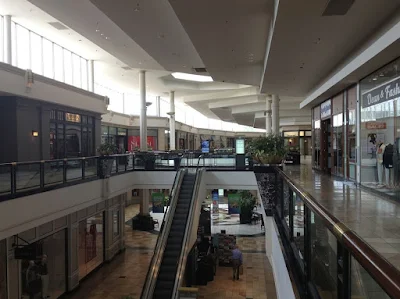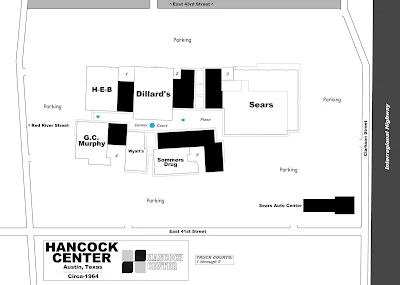Over the years, the BLACK HORSE PIKE mall encountered competition from several major shopping hubs. It enjoyed a brief revival in the 1990s, but was in a downward spiral after its major stores pulled up stakes. The center was demolished in 2004 and replaced by AUDUBON CROSSINGS in 2005. The adjacent complex was also remodeled and renamed AUDOBON COMMONS.
Original photo from www.bing.com
The AUDOBON CROSSINGS WalMart. Its construction was aided by a 1.2 million dollar "roadway improvement" grant from the Delaware River Port Authority.
Photo from www.loopnet.com
AUDOBON COMMONS houses an Acme Savon supermarket and pharmacy. The store opened -in the mid-1950s- as the Penn Fruit grocery seen above.
Photo from http://acmestyleblog.blogspot.com
BLACK HORSE PIKE CENTER
Black Horse Pike and West Nicholson Road
Camden County (Borough of Audubon), New Jersey
In the early 1950s, the J.C. Penney chain was based in New York City. The retailer had begun to expand operations from the central city to the suburbs, with early shopping center stores opening at Columbus, Ohio's TOWN & COUNTRY CENTER (1950), Memphis, Tennessee's POPLAR HIGHLAND PLAZA (1952) and Sacramento's COUNTRY CLUB CENTRE (1952).
These were "dry goods only" operations, encompassing between 8,000 and 60,000 square feet. They carried lines of men's and women's apparel, fashion accessories, linens and the like. With the 1960s came a new concept. J.C. Penney decided to build full-line stores in suburban malls and strip centers, to compete with rivals Sears and Montgomery Ward.
These New Generation Penney's stores would offer the aforementioned soft lines, but also sell furniture, sporting goods, paint, hardware, appliances and electronics. Stores often included a restaurant or snack bar, beauty salon, portrait studio, optical department, garden center and an attached, or freestanding, Auto Center.
Penney's Audobon at BLACK HORSE PIKE CENTER was a stepping stone between the dry-goods-only operations and larger New Generation stores. It encompassed 2-levels and over 80,000 square feet. The store welcomed its first shoppers on November 16, 1961.
BLACK HORSE PIKE CENTER was developed by Philadelphia's M.A. Kravitz Company and designed by George W. Neff & Associates, of Philadelphia. A groundbreaking was held on October 11, 1960, at a 33-acre site, located 4.9 miles southeast of Center City Philadelphia.
The first operational store, a 2-level (130,000 square foot) E.J. Korvette discount mart, opened for business on August 31, 1961. Korvettes was joined by Thrift Drugs, Miles Shoes, Bond Clothes, Singer Sewing Center, an F.W. Woolworth 5 & 10 and the aforementioned Penney's. When fully-realized, the single-level, open-air mall encompassed approximately 497,000 leasable square feet.
BLACK HORSE PIKE CENTER was soon outclassed by several large interior malls built in its vicinity. These included CHERRY HILL MALL (1961) {4.8 miles northeast, in Camden County}, MOORESTOWN MALL (1963) {7 miles northeast, in Burlington County}, ECHELON MALL (1970) {5.2 miles southeast, in Camden County} and DEPTFORD MALL (1975) {3.9 miles southwest, in Gloucester County}.
The BLACK HORSE PIKE property persevered, but was dealt a blow when its Korvettes went bust in February 1980. It was followed by a 1-level (85,000 square foot) Woolco, which held its grand opening October 7, 1981. This turned out to be a poor replacement, as this chain folded in January 1983. On October 3, 1985, a Braintree, Massachusetts-based Bradlees discount mart was dedicated.
This store lasted until March 2001. J.C. Penney went dark in July of the same year. Woolworth had shut down in July 1997. By the early 21st century, there were only twelve BLACK HORSE PIKE stores in operation. These included Fashion Bug, First Union Bank, J.R. Dollar Store, East Coast Furniture Liquidators, Radio Shack, Lucky Star Chinese Buffet, a Subway sandwich shop and US Post Office.
The owners of the property, Pennsylvania's Wolfson Verrichia Group, decided that a complete reconstruction of the aging shopping center was in order. An adjacent (110,000 square foot) cluster of stores, anchored by an Acme supermarket, would also be redeveloped. Original sections of BLACK HORSE PIKE CENTER were razed in 2004, with the groundbreaking for a new complex held on September 14.
The new AUDUBON CROSSINGS strip center was dedicated October 26, 2005. It encompassed approximately 388,400 leasable square feet and was anchored by Staples, Pep Boys automotive and a 1-level (137,000 square foot) Wal-Mart SuperCenter. Inline stores included Avenue, Payless ShoeSource, Dot's and Deb Shops. The adjacent, Acme-anchored complex was renamed AUDUBON COMMONS.
Years later, several AUDOBON CROSSING stores had been shuttered. Their area was gutted and expanded into space for new retailers. A (25,000 square foot) Ross Dress For Less and (23,000 square foot) Marshalls welcomed their first shoppers on October 7, 2017.
Sources:
The Courier-Post (Camden, New Jersey)
http://www.departmentstorehistory.net
http://www.boroughofaudubon.com
http://www.retailtraffic.com
http://www.flickr.com/photos/42444189@N04/3972393065/sizes/o/in/photostream / "JSFo864"
www.philly.com
http://theretrospect.com / "Audubon Shopping Center's Opening"





















































